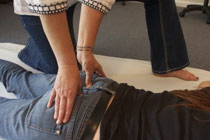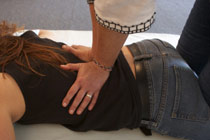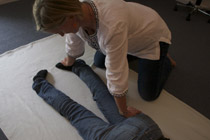Shiatsu
The History of Shiatsu
 Shiatsu, based on Traditional Chinese Medicine (TCM), originated in Japan (Shiatsu Society, UK). TCM including massage, acupuncture and herbalism was introduced into Japan in the 6th century (Shiatsu Society, UK). The Japanese refined the methods of TCM and developed its own style of "manual healing and diagnostic arts", which are used in today's Shiatsu(Shiatsu Society, UK)).
Shiatsu, based on Traditional Chinese Medicine (TCM), originated in Japan (Shiatsu Society, UK). TCM including massage, acupuncture and herbalism was introduced into Japan in the 6th century (Shiatsu Society, UK). The Japanese refined the methods of TCM and developed its own style of "manual healing and diagnostic arts", which are used in today's Shiatsu(Shiatsu Society, UK)).
Shiatsu had been used in Japan for hundreds of years until it was banned during the U.S. occupation of Japan after World War II (Salvo, 2007, p. 756). In the 1950s, Tokujiro Namikoshi came up with a style of shiatsu which "used Western anatomy references instead of traditional nomenclature" (Salvo, 2007, p. 756). The Ministry of Health in Japan therefore approved this style of shiatsu as medical treatment, which is still very popular in Japan today (Salvo, 2007, p. 756). In 1953, Shiatsu was first introduced to North America as a Japanese healing art when the Palmer Chiropractic School in Iowa, USA, invited Namikoshi and his son to teach the art (Fullington).
 Shizuto Masunaga studied with Namikoshi but took a different approach and created Zen Shiatsu (Salvo, 2007, p. 756). He was a psychologist who studied the ancient Chinese medicine (Salvo, 2007, p. 756). After a lot of research, he came up with "an expanded model of health in which emotional and mental aspects of the person were taken more into consideration and blended into the physical touch technique of Zen Shiatsu" (Salvo, 2007, p. 756). He also created a new chart of meridians including extensions of the meridian pathways, which is still used by worldwide shiatsu schools today (Salvo, 2007, p. 756). In the 1970s, he brought Zen Shiatsu to the United States where he continued to develop his theory until his death in 1981 (Stewart).
Shizuto Masunaga studied with Namikoshi but took a different approach and created Zen Shiatsu (Salvo, 2007, p. 756). He was a psychologist who studied the ancient Chinese medicine (Salvo, 2007, p. 756). After a lot of research, he came up with "an expanded model of health in which emotional and mental aspects of the person were taken more into consideration and blended into the physical touch technique of Zen Shiatsu" (Salvo, 2007, p. 756). He also created a new chart of meridians including extensions of the meridian pathways, which is still used by worldwide shiatsu schools today (Salvo, 2007, p. 756). In the 1970s, he brought Zen Shiatsu to the United States where he continued to develop his theory until his death in 1981 (Stewart).
Today, Shiatsu has developed into various styles and approaches. Some focus on acupressure or acupuncture points; some emphasize "more general work on the body or along the pathways of energy" to influence the Qi flow; and others highlight diagnostic systems (Shiatsu Society (UK)). Each Shiatsu practitioner incorporates his own understanding and creates his own individual style (Stewart).
Shiatsu has become the most widely practiced form of Asian bodywork in North America and Europe Today (The Ohio State University Wexner Medical Center).
What Is Shiatsu?
 Shiatsu is a Japanese bodywork therapy which "uses pressure on the surface of the skin along energy channels called meridians to regain and maintain a harmonic flow of energy throughout the body-mind-spirit" (Salvo, 2007, p. 756). The word "Shiatsu" literally means "finger pressure", although hands, elbows, knees and feet are also used as well as joint movements and stretches if necessary (Salvo, 2007, p. 756).
Shiatsu is a Japanese bodywork therapy which "uses pressure on the surface of the skin along energy channels called meridians to regain and maintain a harmonic flow of energy throughout the body-mind-spirit" (Salvo, 2007, p. 756). The word "Shiatsu" literally means "finger pressure", although hands, elbows, knees and feet are also used as well as joint movements and stretches if necessary (Salvo, 2007, p. 756).
Note: Meridians are pathways of energy which "distribute, balance, and connect the Qi of the interior organs with the surface and exterior of the body" (Salvo, 2007, p. 758. More information at The Meridian System: Channels of Awareness).
Christina Polnyj is a Shiatsu instructor at Florida School of Massage, who has 20 years of experience in teaching and practicing Shiatsu. In this video, she gives us her story about Shiatsu.
Health Benefits
Shiatsu aims to help recipients to maintain a harmonious Qi (energy) flow in the body, mind, and spirit along the meridians (Salvo, 2007, p. 756). An imbalance of Qi flow can result in symptoms of poor health. By working on the Qi flow of the body, Shiatsu provides an effective way to facilitate pain relief, digestion, breathing, waste elimination, and blood circulation. It can boost theimmune system, change sleep patterns, increase mobility, and reduce anxiety and depression (Salvo, 2007, p. 756; International School of Shiatsu). Ultimately recipients will feel invigorated and at the same time relaxed (Salvo, 2007, p. 756).
